Ultimate Guide to Rabbit Clippers for Grooming Care
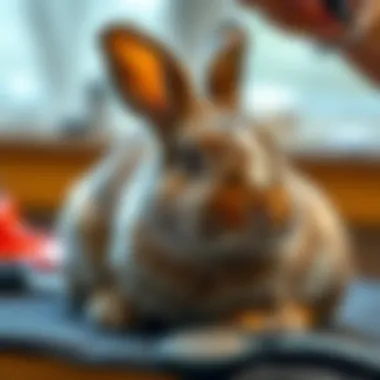
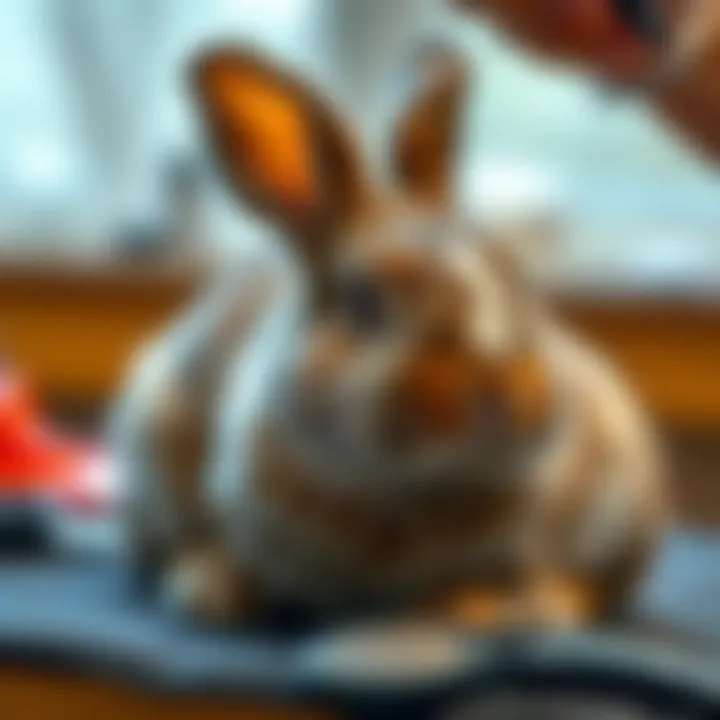
Intro
As a rabbit owner, you’re not only responsible for providing food and shelter but also for their grooming needs. Unlike some pets, rabbits have unique fur that requires special attention to keep it healthy and manageable. Clipping your rabbit's fur is a significant part of this care that can’t be ignored. It helps prevent matting and keeps them comfortable, especially during the warmer months. Here we’ll dive into essential considerations for selecting and using clippers specifically designed for rabbits. From understanding different rabbit breeds to maintaining your grooming tools, this guide aims to arm you with the knowledge you need for a positive grooming experience.
Pet Care and Grooming
Importance of Regular Care
Regular grooming is a cornerstone of a rabbit's health and comfort. Neglecting this can lead to various issues, including skin irritations, matting, or even health complications that are more serious if left unattended. Rabbits have delicate skin, and their fur can trap moisture and dirt, leading to potential fungal infections. Establishing a consistent grooming routine not only benefits your pet's appearance but also offers an excellent opportunity for bonding.
Grooming Techniques by Rabbit Type
Depending on the breed, grooming needs can vary dramatically:
- Long-haired breeds like the Angora require frequent brushing to avoid tangles and mats. It's advisable to use a slicker brush along with clippers for better results.
- Short-haired breeds like the Holland Lop need less frequent grooming but might still require occasional clipping around the hindquarters for hygiene.
It's helpful to understand your rabbit's specific coat type to employ the appropriate grooming techniques.
Tools and Products Recommendations
Choosing the right clippers is critical for effective grooming. A popular choice among rabbit owners is the Andis ProClip AGC2. This model is known for its heat control, ensuring that your rabbit stays comfortable during grooming sessions. Additionally, the Wahl Bravura is another solid option; its cordless feature allows for easier maneuverability.
Other grooming tools to consider:
- Slicker brush: helps remove loose fur and prevents tangles.
- Comb: useful for detangling fur around sensitive areas.
- Nail clippers: essential for keeping your rabbit’s nails trim to avoid injuries.
Seasonal Care Tips
As the seasons change, so do your rabbit's grooming needs. In spring and summer, rabbits tend to shed more. Regular brushing can help manage this, ensuring that loose fur doesn't end up as a furball around your home. Conversely, in the winter months, you might consider a light trim to avoid heavy mats while still keeping your rabbit warm. Always monitor their behavior during grooming; if they seem anxious, take a break to let them relax.
"Regular grooming not only maintains your rabbit's health but also enriches your bond with them."
By investing time in mastering the art and science of rabbit grooming, you set the stage for a happier, healthier pet.
Understanding Rabbit Grooming
Grooming is more than just a beauty regimen for rabbits; it’s an essential aspect of their overall health and wellbeing. Just like brushing your own hair helps to prevent tangles and maintain strength, grooming rabbits regularly serves to keep their coats clean and free of mats. Quite a few rabbit owners overlook this aspect, assuming that their fuzzy friends will manage on their own. However, a thorough understanding of rabbit grooming can lead to healthier pets and less stress for both owner and animal.
Importance of Regular Grooming
Regular grooming is crucial for a multitude of reasons. Firstly, it helps to remove loose fur, dander, and dirt. Rabbits shed, and during spring and fall, this can turn into a full-blown fur explosion. Frequent grooming not only keeps your living space cleaner but also lessens the amount of fur that circulates in the air, which can be a relief for allergy sufferers.
In addition, a well-groomed rabbit is less likely to suffer from skin issues. Matted fur can trap moisture and heat, creating a perfect breeding ground for bacteria. Preventative grooming allows for early detection of potential skin problems, such as irritations or infestations. This proactive approach can save both time and costly veterinary bills in the long run.
Moreover, grooming fosters a strong bond between you and your rabbit. The act of brushing or combing can be quite soothing when done correctly, turning it into a calming experience. Just as one would enjoy a good hair trim at a salon, many rabbits come to appreciate this attention when it’s introduced in a gentle and consistent manner.
Effects of Neglecting Grooming
When grooming takes a backseat in your rabbit's care, the effects can be dire. Ignoring regular maintenance can lead to a host of issues. For one, neglected fur can become matted or knotted. Once this happens, it can require professional grooming to fix, not to mention it can cause severe discomfort for your rabbit.
Additionally, poor grooming practices can lead to health complications, such as the risk of mega-colon, a condition linked to ingesting excessive fur during self-grooming. This can happen when rabbits try to eat around mats and end up swallowing more hair than normal. Resulting in significant gastrointestinal issues that could affect their overall wellbeing.
Furthermore, a lack of grooming often leads to the buildup of debris and pests. If not monitored, this can escalate to skin infections or parasitic infestations, causing both discomfort and serious health risks. In the worst case, neglected grooming could endanger your rabbit's life if it leads to severe health complications.
Choosing the Right Clippers
Choosing the right clippers is an essential aspect of rabbit grooming that can make a significant difference in the overall experience for both the pet and the owner. With various styles and designs available, understanding the nuances that set each type apart is vital. From electric to manual options, the right choice can enhance not only the efficiency of grooming but also the comfort and safety of the pet involved. Selecting clippers that suit both the coat type of the rabbit and the grooming skill level of the owner will result in a more positive outcome.
Types of Clippers for Rabbits
Electric Clippers
Electric clippers stand as one of the more popular choices in the realm of rabbit grooming. Their primary hallmark is efficiency—they often get the job done quicker than their manual counterparts. A significant advantage of electric clippers is their ability to handle thicker or matted fur with ease, which is crucial for longer-haired breeds like the Angora.
However, they do come with some considerations. For starters, some models can be a bit noisy, which might unsettle a shy rabbit. A gentle approach with the clippers can minimize this issue, ensuring a smoother experience. It's also worth noting that investing in quality electric clippers ensures durability and performance, ultimately saving time and reducing stress for your pet during grooming.
Manual Clippers
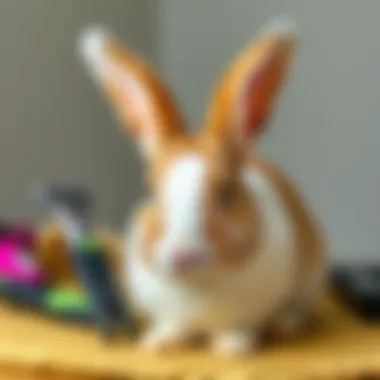
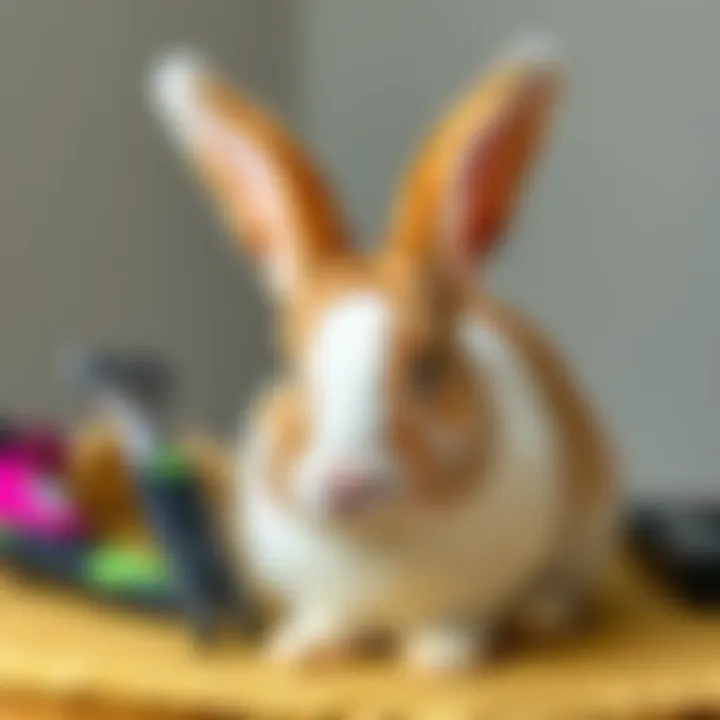
Switching gears to manual clippers, these often come into play for hobbyists or those who prefer a hands-on approach. One of the primary benefits of manual clippers is their control—owners can trim with precision and adjust their technique as needed. They are particularly useful for sensitive areas such as around the ears or paws.
On the flip side, however, manual clipping can demand more time and patience. If your rabbit has a thick coat, it may take quite a while to get through. Still, they are generally lighter and quieter than electric options, making them a good choice for nervous rabbits.
Specialized Rabbit Clippers
Specialized rabbit clippers, as the name suggests, are designed specifically for the nuanced needs of common rabbit breeds. These clippers often come with safety features such as rounded tips to avoid nicks and cuts. The primary characteristic is their tailored design that accommodates the unique coats and temperaments of rabbits. Owners often find them easier to handle, especially when trimming down the fur without the risk of injury.
However, these clippers might be pricier than standard options, which can be a consideration for budget-conscious rabbit owners. Nonetheless, they are an investment in your pet's grooming comfort and safety, ultimately leading to a positive experience for both rabbit and owner.
Key Features to Consider
Blade Quality
When diving into the specifics of clippers, blade quality should never be overlooked. A high-quality blade can significantly impact the grooming experience, providing a smooth cut without pulling or tugging at the rabbit's fur. Blades made of stainless steel are often durable and resist rust, making them a long-lasting choice.
Even more important is ensuring that the blades can maintain sharpness. Dull blades can lead to discomfort for the rabbit and a less effective grooming session, which, frankly, no one wants.
Noise Level
Moreover, noise level is another crucial aspect to think about when selecting clippers. Electric clippers, while effective, might produce a considerable amount of sound that could alarm a skittish rabbit. Lower-noise options are available and can often make a big difference in keeping the creature calm and at ease throughout the process.
Weight and Ergonomics
Lastly, let's not forget about weight and ergonomics. As you might imagine, grooming can take some time, so it's important to choose clippers that feel comfortable in your hand. Lightweight clippers can alleviate fatigue and allow for more extended periods of grooming without discomfort. Ergonomically designed clippers often provide more control, which is essential when working on delicate areas.
"A well-groomed rabbit is a happy rabbit."
To better understand the types and features of clippers that may suit your needs, you can refer to resources like Wikipedia on Pet Grooming, or the forums at Reddit dedicated to Rabbit Care.
Choosing the right clippers can not only enhance the grooming process but also contribute towards a happier and healthier life for your beloved rabbit.
Preparing Your Rabbit for Grooming
Preparing your rabbit for grooming is more than just a practical step; it’s a vital part of ensuring a stress-free experience for both you and your pet. Rabbits can be skittish creatures, and introducing them to the grooming process requires a thoughtful approach. The right preparations can make all the difference in how your rabbit behaves and feels during grooming sessions.
Creating a Calm Environment
Before you even pick up the clippers, establishing a peaceful setting is crucial. Rabbits are sensitive to their surroundings, and loud noises or chaotic environments can send them into a tailspin. Here are some pointers to simplify the process:
- Choose a Quiet Space: Opt for a room away from daily hustle and bustle. A quiet corner can work wonders.
- Comfort Items: Use soft blankets or favorite toys to create a familiar and cozy zone. This can help soothe their nerves.
- Time it Right: Pick a time when your bunny is usually calm, like just after a meal or during their naptime.
With the right environment set up, your rabbit will be more at ease and ready for its grooming.
Bonding with Your Rabbit Before Grooming
Building Trust
Building trust is the cornerstone of a successful grooming experience. Taking the time to earn your rabbit's trust pays off significantly in their willingness to be groomed. This involves gentle interactions, allowing them to come to you at their own pace.
- Repetitive Positive Interactions: Simple petting or offering treats can foster a positive connection.
- Stay Low and Calm: Approach your rabbit on their level. This reduces intimidation and makes you seem less like a predator.
- Routine: Establish a consistent routine that includes grooming. Familiarity breeds comfort, and rabbits thrive on predictability.
The unique feature of trust-building is its direct impact on your rabbit's comfort level. It can turn a previously anxious pet into a cooperative grooming buddy, which is a huge advantage in the long run.
Handling Techniques
Understanding proper handling techniques cannot be overstated. How you physically handle your rabbit will significantly influence their comfort and cooperation during grooming.
- Support Their Body: Always support their hindquarters and avoid holding them too tightly. A gentle, firm grip goes a long way.
- Rabbits Prefer Grounded Positions: Grooming sessions on a stable surface can feel more secure to your rabbit than being held in the air.
- Breath with Patience: If your rabbit squirms, take a moment to calm them down and try again, ensuring you're not forcing anything.
The unique advantage of mastering handling techniques is the reduction of stress for both the rabbit and the owner. A relaxed bunny is easier to groom, yielding a far more pleasant grooming experience.
"Taking the time to prepare and bond with your rabbit before grooming lays the groundwork for a positive experience. Trust and comfort can significantly alter their reaction to clippers."
Grooming Techniques for Effective Clipping
When it comes to grooming rabbits, employing the right techniques is essential for both their comfort and the efficiency of the clipping process. Proper grooming techniques do not just ensure the rabbit looks good; they also help prevent matting and skin issues that can arise from poor maintenance. Knowing how to section the coat effectively and using clippers correctly can turn a chore into a smooth experience, for both the pet and the owner.
Sectioning the Coat
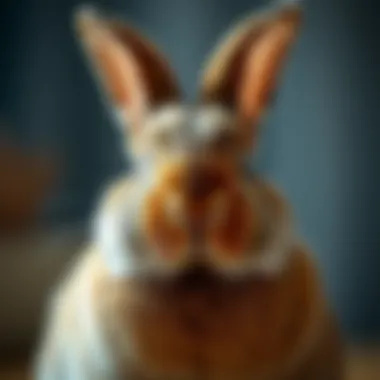
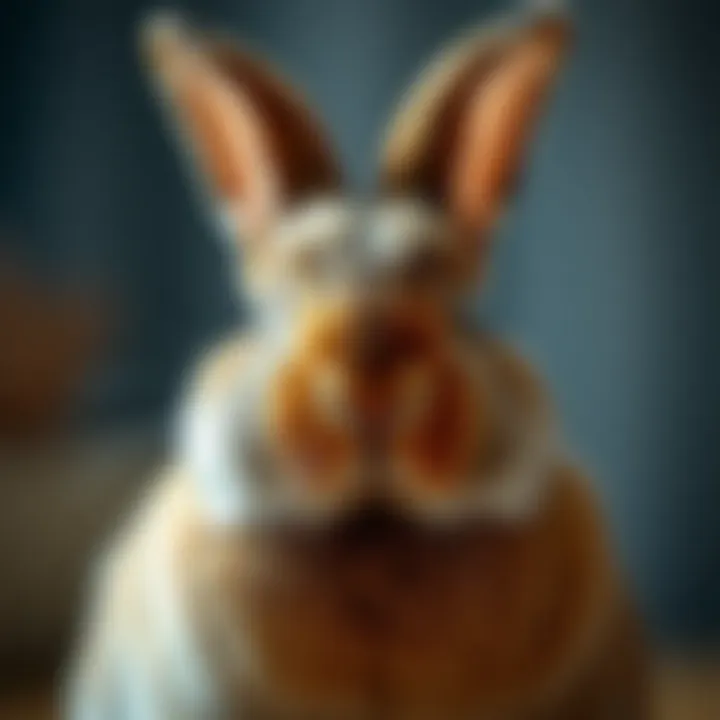
Sectioning the coat is a pivotal technique in rabbit grooming. It's about breaking the bunny's fur into manageable portions so you can really focus on each area without overwhelming the animal. Think about using a comb to separate the fur into neat sections. This method not only keeps things organized but also allows you to keep an eye out for any knots or clumps that may require more attention.
For instance, when you clear a specific section, you can see if there's any dirt or debris trapped in the fur. This careful approach helps you to use your clippers more effectively, minimizing the potential for pulling on the rabbit’s skin. Don't rush; this isn’t a race. Spending that little extra time at this stage can save you from a lot of hassle later on.
Clipper Usage Tips
How you handle the clippers can make or break the grooming experience. Here are some essential tips to bear in mind:
Direction of Clipping
Clipping in the right direction is crucial to the overall outcome of the grooming session. Generally, you want to clip in the direction the hair grows. This method is key not just for aesthetics but for the rabbit’s skin integrity too. Clipping against the grain can irritate their skin and create discomfort.
For instance, if your rabbit's fur grows downwards, move the clippers downwards too. It’s a simple yet effective strategy that will keep your rabbit calm and make the process efficient. Some rabbit owners find this technique gives a neater finish, which is an added bonus. However, if you're cutting in a tricky area, don’t be afraid to adjust the direction as needed.
Speed Control
Most quality clippers come with adjustable speed settings, and learning to use these features can significantly improve your clipping experience. Slower speeds allow for finer control, which is especially useful around sensitive areas like the belly and tail. On the other hand, a higher speed can help you get through thick parts of the coat quickly, saving time.
Having that level of control means less chance of accidents. You don't want the clipper buzzing loudly or quickly; that could scare your rabbit and lead to a bad experience all around. The key here is to know your rabbit and adjust the speed according to their comfort level.
Technique for Sensitive Areas
Some areas on a rabbit's body are more sensitive than others, and clipping these areas requires extra caution. Areas such as around the eyes, ears, and underbelly can cause discomfort if not handled delicately. Using a smaller blade or guard can help you navigate these areas safely.
It's always a good idea to use gentle strokes and take your time. Ensuring that your rabbit feels secure during these motions can go a long way. Additionally, consider holding the rabbit securely while you work, minimizing any potential jumps or scares.
"Taking an extra moment to prepare and understand your pet's needs can make all the difference in a grooming session."
By following these techniques, you're not just clipping fur; you're nurturing a trusting relationship with your rabbit, which is the ultimate goal in grooming.
Maintaining Your Clippers
Maintaining your clippers is not just about keeping them shiny and sharp; it plays a vital role in ensuring a smooth grooming experience for your rabbit. Proper care extends the life of your clippers, enhances performance, and ensures the well-being of your furry companion during grooming sessions. If neglected, dull or dirty clippers can cause discomfort or even skin irritation to your pet, turning grooming into a dreaded ordeal. Here, we will discuss essential aspects of clipper maintenance, from routine cleaning procedures to knowing when it's time to say goodbye to your clippers.
Regular Cleaning Procedures
Cleaning your clippers regularly is a no-brainer—clean clippers are effective clippers. After each use, it’s crucial to wipe down the blades with a soft cloth to remove hair and debris. Additionally, using a small brush or air blower can help dislodge any trapped fur that may have settled in hard-to-reach areas.
To keep things sanitary, dip the blades in a disinfectant solution designed for clippers, then rinse and dry them thoroughly. Make this a habit after every grooming session. Just like humans, clippers benefit from a little spa treatment.
- Why Clean Regularly?
- Reduces the risk of infections for your rabbit.
- Ensures consistent performance of the clippers.
- Lengthens the lifespan of your grooming tools.
Sharpening the Blades
Sharp blades are essential for a clean cut and can drastically reduce the stress of grooming for both you and your rabbit. Over time, even the best clippers will dull, especially if used frequently. When you notice that the clippers are pulling at the fur rather than cutting smoothly, it’s time for a sharpening session.
While some owners opt to send their clippers to a professional for sharpening, there are DIY methods available, such as using a sharpening stone. However, if you’re not comfortable with this, it’s always best to consult a technician to ensure the blades remain in optimal condition.
When to Replace Clippers
Even with the best maintenance efforts, there will come a time when replacements are necessary. Look for signs such as overheating, excessive noise, or erratic performance as indicators that your clippers may need replacing. Don’t wait until you have a grooming disaster on your hands.
Consider replacing your clippers if:
- Blades show significant wear and cannot hold a sharp edge.
- The motor functions erratically or doesn’t start at all.
- There is a notable increase in vibrations or noise while operating.
Regular maintenance keeps your clippers functioning efficiently, ensuring that every grooming session is as stress-free as possible for both you and your rabbit.
Post-Grooming Care
After a grooming session, the care you provide your rabbit plays a crucial role in their overall well-being. Just like humans, animals can feel stressed, and it’s vital to ensure they are comfortable after being clipped. Post-grooming care not only helps in monitoring your rabbit's stress levels but also enhances their grooming experience, making it more positive.
Recognizing Signs of Stress
Understanding how your rabbit feels after grooming is essential. Rabbits can be quite expressive, although sometimes subtle, about their discomfort. Signs of stress might include:
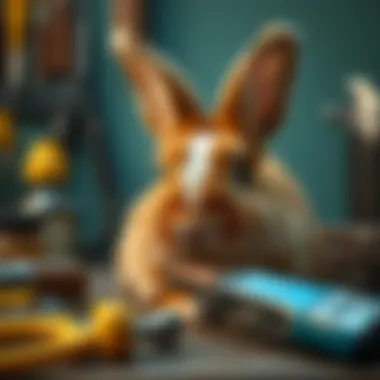
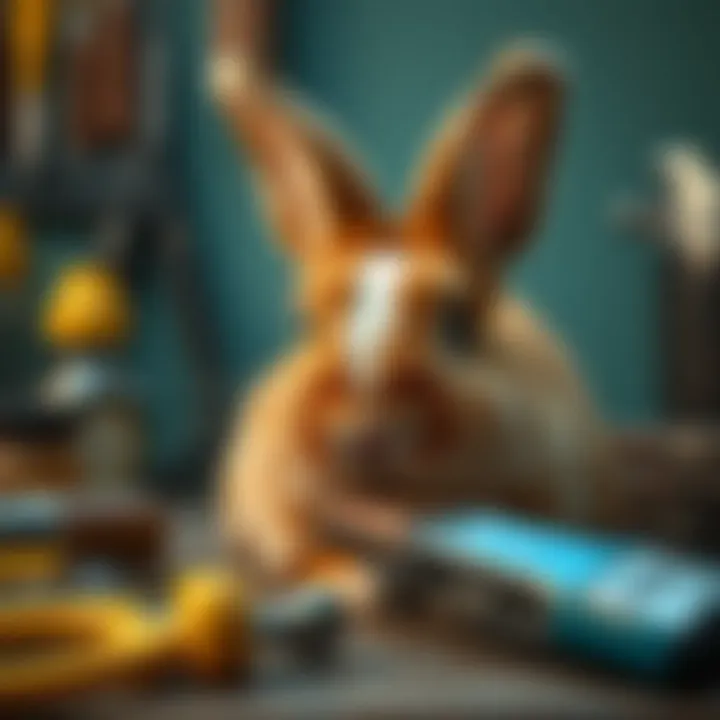
- Ears back: If their ears are pinned back against their body, it might signal annoyance or fear.
- Thumping: You might notice your rabbit thumping its hind legs. This unique behavior is a common warning sign they’re not happy.
- Hiding or withdrawing: After grooming, if your rabbit seeks out a dark corner or attempts to hide, this can indicate uncomfortableness or stress.
Recognizing these signs in your rabbit’s body language helps you to immediately address any issues. A little extra care goes a long way in turning a stressful experience into a more relaxed one.
Aftercare for Skin and Coat
Once the clippers have buzzed their last, it’s important to focus on how to keep the rabbit’s skin and coat healthy. Post-grooming care involves more than simply putting the clippers down; it requires a deliberate aftercare routine to ensure your pet’s skin does not suffer from irritation or dryness.
Daily Grooming Routine
Implementing a daily grooming routine is a proactive way to maintain your rabbit's health post-grooming. This practice not only keeps coat shedding at bay but also checks for any skin irritations that may arise. The key characteristic of a daily grooming routine lies in its consistency—it’s beneficial to make it a part of your rabbit's daily care schedule. Regularly using a soft-bristle brush is a popular choice among many rabbit owners for several reasons:
- It removes loose fur, preventing mats and tangles.
- It promotes healthy blood circulation in your rabbit’s skin, fostering a shiny coat.
- It offers an opportunity to bond, as rabbits often appreciate the sensation of being brushed.
One unique feature of daily grooming is that it enables you to keep a watchful eye on your rabbit’s skin. It allows you to identify early signs of health issues. However, it’s important to avoid excessive grooming, which can lead to skin sensitivity.
Using Moisturizers and Conditioners
Adding moisturizers and conditioners to your aftercare can make a world of difference for your rabbit's coat and skin. After a clipping, their skin can become dry. This is where the right moisturizer comes into play. Using a rabbit-safe moisturizer not only hydrates the skin but also can help soothe any irritation caused during the grooming process. It is essential,
- To look for products specifically designed for rabbits or pets, as they can be quite different from human moisturizers.
- A unique feature of using conditioners is that they can enhance the shine and smoothness of your rabbit's fur.
That said, not all moisturizers are created equal. Some may contain chemicals or fragrances that could irritate your rabbit’s sensitive skin. Thus, always read labels carefully and consult with a veterinarian if unsure.
"A little goes a long way with moisturizers, so use sparingly and only when necessary."
Common Mistakes to Avoid
Grooming rabbits is an essential aspect of their care, but like any task, there are a few common blunders that can make the process stressful not just for the pet but for the owner as well. Avoiding these missteps not only ensures a smoother grooming experience but also nurtures a stronger bond between you and your bunny. Considering the needs of your rabbit and using the right techniques will lead to a more comfortable and effective grooming session.
Inappropriate Clip Lengths
When it comes to clipping your rabbit's fur, understanding the appropriate clip lengths is crucial. Each breed has unique coat characteristics, and choosing the wrong length can lead to discomfort or worse. For example, some breeds, like Angoras, have long, fluffy coats that may require deeper clipping during hot months. If you mistakenly leave the fur too long, it can trap heat, makingyour rabbit susceptible to overheating.
On the flip side, clipping too short can expose the delicate skin of your rabbit, which can lead to irritation or injury. As you wield your clippers, consider starting with a longer guard to assess how your rabbit responds, gradually switching to shorter ones if necessary. Clip lengths of about half an inch are often a safe middle ground for most breeds.
Key points to keep in mind when selecting clip lengths:
- Always assess your rabbit's specific breed and coat type.
- Start with longer guard options for a gentler approach.
- Monitor your rabbit's comfort level during the process.
Understanding clip lengths and adjusting according to your rabbit’s needs can save you a lot of trouble down the line.
Ignoring Rabbit's Needs
Another pitfall that many novice rabbit groomers encounter is ignoring the immediate needs and behaviors of the rabbit. Just like humans, rabbits have preferences and aversions, and failing to recognize these signs can turn grooming into a nightmare for both parties.
For example, if your rabbit begins to squirm or exhibit signs of stress, it might indicate that they are uncomfortable with the clippers or the position in which they are being held. Taking a step back to re-evaluate could be the difference between a successful grooming and a traumatizing experience. Pay attention to non-verbal cues, such as flattening ears or trying to hop away. These behaviors can inform your approach and adjustments during grooming, allowing you to modify your technique or take breaks as needed.
A rabbit that feels respected and listened to will often cooperate more willingly during grooming sessions.
When in doubt, always prioritize the well-being of your rabbit. A relaxed rabbit not only makes your job easier but also establishes trust between you, paving the way for happier grooming experiences in the future.
Making an effort to avoid these common mistakes will ensure that your rabbit’s grooming is a productive and pleasant part of their care routine. This awareness elevates not just the standard of care but also enriches the bond you share with your furry friend.
Culmination
The process of grooming rabbits is not merely a matter of aesthetics; it carries significant implications for the well-being of your furry companion. Proper grooming plays a vital role in maintaining your rabbit's health, ensuring they remain comfortable and free from potential health issues. When clipping their fur, it’s crucial to select the right tools and apply effective techniques. This ensures a smooth experience without causing stress to the animal.
In this guide, we explored the various aspects of rabbit grooming, touching on essential considerations such as the types of clippers suited specifically for rabbits and techniques for effective clipping. By understanding these components, you as a pet owner can cultivate a nurturing environment for your rabbit during grooming, ultimately building a stronger bond with them.
"A happy rabbit is a well-groomed rabbit."
Moreover, maintaining your clippers and being aware of the signs of stress your pet may exhibit can greatly enhance their grooming experience. The bottom line here is that through regular grooming, not only do you keep your rabbit looking its best, but you also assure their comfort and health. Regular checks, coupled with an attentive approach, go a long way in achieving optimal care. It's an investment—not just in time or tools, but in the joyous relationship you have with your pet.
Recap of Key Points
- Importance of Grooming: Regular grooming prevents matting and potential skin issues while fostering a deeper bond with your rabbit.
- Clipper Selection: Electric, manual, or specialized clippers are key to the comfort and safety of your rabbit. Choose based on your needs and your pet's temperament.
- Preparation and Environment: A calm setting aids in minimizing stress. Bonding with your rabbit before grooming is equally important.
- Techniques: Employing the right techniques ensures effective clipping, particularly in sensitive areas.
- Post-Grooming Care: Aftercare is essential. Keeping tabs on their stress signals can help in making the experience better for both the rabbit and the owner.
- Common Mistakes: Avoid inappropriate clip lengths and always be attentive to your rabbit’s needs and preferences.
Encouragement for Rabbit Owners
As a rabbit owner, you're entrusted with the care of a delicate creature capable of deep emotional connections. Your efforts in grooming can significantly impact your rabbit's overall quality of life. Don’t hesitate to take your time during grooming sessions; patience goes a long way. Each stroke with the clipper can either soothe or distress your rabbit, so be attentive to their reactions.
Engage in the grooming experience with curiosity and compassion, reminding yourself that this is an opportunity to deepen your relationship.
Seek support from resources or fellow rabbit enthusiasts in forums or community groups to learn more tips and tricks. The journey of grooming can be challenging, but with dedication and the right approach, it is undoubtedly rewarding. Keep nurturing that bond, and remember you are making a difference in your rabbit's happiness and health.















